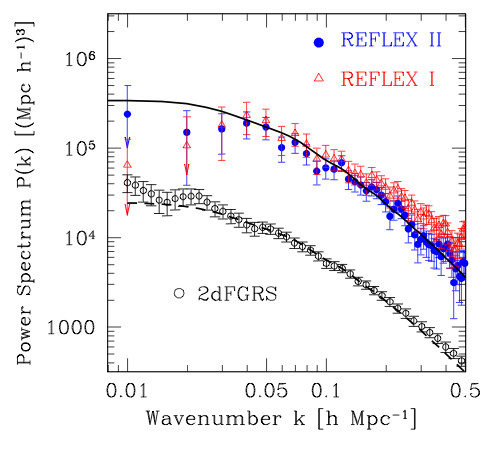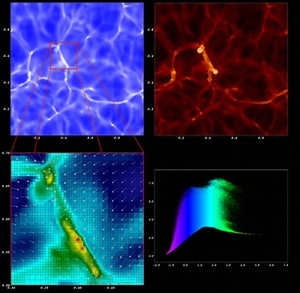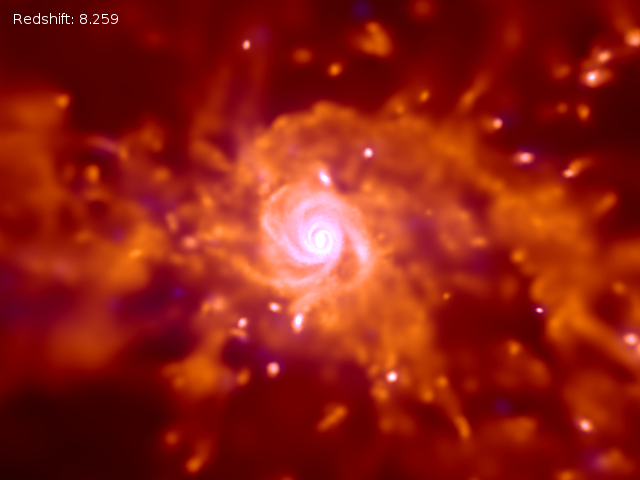Our work
Our research interests mainly concern the formation and evolution of structure in the Universe. We use a variety of analytical and numerical techniques to address these issues; N-body simulations, analytical models and current observational data-sets allow for focused research programmes intended to shed new light on the old problem of structure formation. Broadly, our research efforts focus on:
A list of our recent publications can be found here.We acknowledge financial assistance from:
- Transregional Collaborative Research Centre TRR 33 - The Dark Universe
- SFB 956 - Conditions and Impact of Star Formation
More details details about our ongoing research can be found below. Opportunities for prospective postdoctoral fellows and students can be found here; potential collaborators are encouraged to contact directly any of our members.

 Galaxies and their purported dark matter halos do not uniformly trace the underlying
non-linear matter density field; an affect commonly referred to as biasing. Accurate
theoretical models describing how the galaxy or halo populations are biased with respect
to the matter are essential for extracting cosmological information from galaxy surveys.
We investigate these issues using bias models in combination with extensions
to linear theory of structure growth: standard perturbation theory;
non-linear local bias and resummed perturbation theories, and non-local bias models.
We assess the validity of the models by comparing various statistical estimators, such as
the dark matter halo power spectrum and bispectrum, directly with the results of fully
non-linear cosmological simulations. (
Galaxies and their purported dark matter halos do not uniformly trace the underlying
non-linear matter density field; an affect commonly referred to as biasing. Accurate
theoretical models describing how the galaxy or halo populations are biased with respect
to the matter are essential for extracting cosmological information from galaxy surveys.
We investigate these issues using bias models in combination with extensions
to linear theory of structure growth: standard perturbation theory;
non-linear local bias and resummed perturbation theories, and non-local bias models.
We assess the validity of the models by comparing various statistical estimators, such as
the dark matter halo power spectrum and bispectrum, directly with the results of fully
non-linear cosmological simulations. ( As a first approximation, the amplitude of the primordial density
perturbations present at the end of inflation follows a Gaussian
distribution. At later times, perturbations become increasingly
non-Gaussian through non-linear structure formation. However, many
inflationary theories predict small deviations from Gaussianity even
before the onset of structure formation. This primordial
non-Gaussianity can have a measurable impact on the statistical
properties of collapsed structures in the universe (e.g. halo mass
function, n-point correlation functions, etc.). By modifying the initial
conditions of cosmological N-body simulations, one can study the
influence of different types of primordial non-Gaussianity on the
evolution of density perturbations at later times. (
As a first approximation, the amplitude of the primordial density
perturbations present at the end of inflation follows a Gaussian
distribution. At later times, perturbations become increasingly
non-Gaussian through non-linear structure formation. However, many
inflationary theories predict small deviations from Gaussianity even
before the onset of structure formation. This primordial
non-Gaussianity can have a measurable impact on the statistical
properties of collapsed structures in the universe (e.g. halo mass
function, n-point correlation functions, etc.). By modifying the initial
conditions of cosmological N-body simulations, one can study the
influence of different types of primordial non-Gaussianity on the
evolution of density perturbations at later times. ( The observed spatial distribution and the
abundance of galaxy clusters provides valuable information on both the
viability of cosmological models as well as on astrophysical properties encoded in
mass-versus-observable scaling relations. The study of galaxy clusters can also provide the
cosmological links required to explore the physical processes behind galaxy formation
and evolution, particularly in dense environments. We study the clustering properties
of these objects using the REFLEX II cataloge; a sample of (how many?) X-ray detected galaxy
clusters. Among other findings, we have shown, for the first time, that the clustering pattern
of the REFLEX II sample exhibits signatures of non-linear evolution. (
The observed spatial distribution and the
abundance of galaxy clusters provides valuable information on both the
viability of cosmological models as well as on astrophysical properties encoded in
mass-versus-observable scaling relations. The study of galaxy clusters can also provide the
cosmological links required to explore the physical processes behind galaxy formation
and evolution, particularly in dense environments. We study the clustering properties
of these objects using the REFLEX II cataloge; a sample of (how many?) X-ray detected galaxy
clusters. Among other findings, we have shown, for the first time, that the clustering pattern
of the REFLEX II sample exhibits signatures of non-linear evolution. ( According to the current cosmological paradigm, all observable
structure in the Universe originated from microscopic primordial
quantum fluctuations generated in the earliest moments of cosmic history.
In the subsequent 13.7 billion years these
tiny "seed" perturbations grew, via gravitational amplification, into the
presently observed matter distribution.
Roughly, the structure formation process follows from the
gravitational aggregation of (yet unknown) dark matter particles in to "halos",
in which baryonic gas can cool and condense,
giving rise to the luminous objects we see in the Universe today.
The process of structure formation involves exciting physics:
quantum field theory; general relativity; gravitational phsyics;
complex hydrodynamics and radiative trasfer.
Throughout cosmic history, all these have left their imprint on
the three-dimensional large scale matter distribution.
According to the current cosmological paradigm, all observable
structure in the Universe originated from microscopic primordial
quantum fluctuations generated in the earliest moments of cosmic history.
In the subsequent 13.7 billion years these
tiny "seed" perturbations grew, via gravitational amplification, into the
presently observed matter distribution.
Roughly, the structure formation process follows from the
gravitational aggregation of (yet unknown) dark matter particles in to "halos",
in which baryonic gas can cool and condense,
giving rise to the luminous objects we see in the Universe today.
The process of structure formation involves exciting physics:
quantum field theory; general relativity; gravitational phsyics;
complex hydrodynamics and radiative trasfer.
Throughout cosmic history, all these have left their imprint on
the three-dimensional large scale matter distribution.
 We plan to perform a suite of cosmological hydro-simulations of
the Intergalactic Medium using
We plan to perform a suite of cosmological hydro-simulations of
the Intergalactic Medium using  Building upon our simulations of the IGM outlined above we plan to implement new, physically-motivated recipes for star
formation on sub-resolution scales. The hydrodynamics of the baryonic gas, coupled to the dark matter via
gravitational forces, will be followed using Eulerian adaptive mesh refinement techniques. We plan to surpass
current implementations of star formation by modelling directly the formation and distruction of several molecular
species thought to play a key role in star formation at in low-mass halos. (
Building upon our simulations of the IGM outlined above we plan to implement new, physically-motivated recipes for star
formation on sub-resolution scales. The hydrodynamics of the baryonic gas, coupled to the dark matter via
gravitational forces, will be followed using Eulerian adaptive mesh refinement techniques. We plan to surpass
current implementations of star formation by modelling directly the formation and distruction of several molecular
species thought to play a key role in star formation at in low-mass halos. ( The large dynamic range probed by current simulations of structure
formation allows for robust measurements of the internal structure of
large samples of dark matter halos spanning a wide range of
masses. The mass profile of CDM halos holds particular interest,
mainly because of its direct connection with key observational probes
of halo structure, such as disk galaxy rotation curves,
gravitational lensing measurements, and more recently because of the
possibility of observing the dark matter directly through its self-annihilation
signal, or in laboratory detectors.
The large dynamic range probed by current simulations of structure
formation allows for robust measurements of the internal structure of
large samples of dark matter halos spanning a wide range of
masses. The mass profile of CDM halos holds particular interest,
mainly because of its direct connection with key observational probes
of halo structure, such as disk galaxy rotation curves,
gravitational lensing measurements, and more recently because of the
possibility of observing the dark matter directly through its self-annihilation
signal, or in laboratory detectors.
